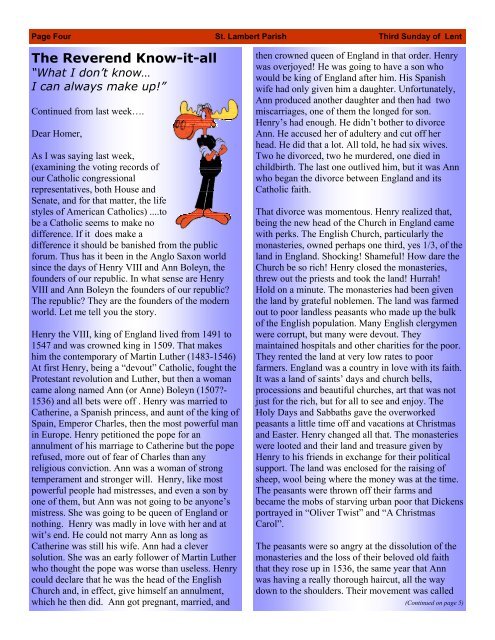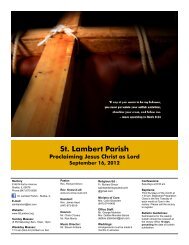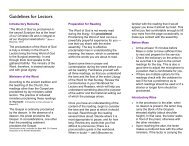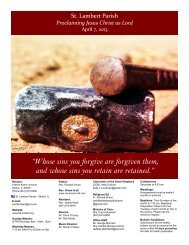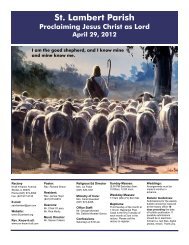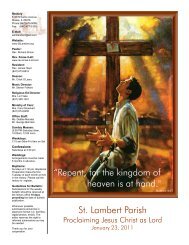St. Lambert Parish
St. Lambert Parish
St. Lambert Parish
Create successful ePaper yourself
Turn your PDF publications into a flip-book with our unique Google optimized e-Paper software.
Page Four <strong>St</strong>. <strong>Lambert</strong> <strong>Parish</strong> Third First Sunday of of Lent<br />
The Reverend Know-it-all<br />
“What I don’t know…<br />
I can always make up!”<br />
Continued from last week….<br />
Dear Homer,<br />
As I was saying last week,<br />
(examining the voting records of<br />
our Catholic congressional<br />
representatives, both House and<br />
Senate, and for that matter, the life<br />
styles of American Catholics) ....to<br />
be a Catholic seems to make no<br />
difference. If it does make a<br />
difference it should be banished from the public<br />
forum. Thus has it been in the Anglo Saxon world<br />
since the days of Henry VIII and Ann Boleyn, the<br />
founders of our republic. In what sense are Henry<br />
VIII and Ann Boleyn the founders of our republic?<br />
The republic? They are the founders of the modern<br />
world. Let me tell you the story.<br />
Henry the VIII, king of England lived from 1491 to<br />
1547 and was crowned king in 1509. That makes<br />
him the contemporary of Martin Luther (1483-1546)<br />
At first Henry, being a “devout” Catholic, fought the<br />
Protestant revolution and Luther, but then a woman<br />
came along named Ann (or Anne) Boleyn (1507?-<br />
1536) and all bets were off . Henry was married to<br />
Catherine, a Spanish princess, and aunt of the king of<br />
Spain, Emperor Charles, then the most powerful man<br />
in Europe. Henry petitioned the pope for an<br />
annulment of his marriage to Catherine but the pope<br />
refused, more out of fear of Charles than any<br />
religious conviction. Ann was a woman of strong<br />
temperament and stronger will. Henry, like most<br />
powerful people had mistresses, and even a son by<br />
one of them, but Ann was not going to be anyone’s<br />
mistress. She was going to be queen of England or<br />
nothing. Henry was madly in love with her and at<br />
wit’s end. He could not marry Ann as long as<br />
Catherine was still his wife. Ann had a clever<br />
solution. She was an early follower of Martin Luther<br />
who thought the pope was worse than useless. Henry<br />
could declare that he was the head of the English<br />
Church and, in effect, give himself an annulment,<br />
which he then did. Ann got pregnant, married, and<br />
then crowned queen of England in that order. Henry<br />
was overjoyed! He was going to have a son who<br />
would be king of England after him. His Spanish<br />
wife had only given him a daughter. Unfortunately,<br />
Ann produced another daughter and then had two<br />
miscarriages, one of them the longed for son.<br />
Henry’s had enough. He didn’t bother to divorce<br />
Ann. He accused her of adultery and cut off her<br />
head. He did that a lot. All told, he had six wives.<br />
Two he divorced, two he murdered, one died in<br />
childbirth. The last one outlived him, but it was Ann<br />
who began the divorce between England and its<br />
Catholic faith.<br />
That divorce was momentous. Henry realized that,<br />
being the new head of the Church in England came<br />
with perks. The English Church, particularly the<br />
monasteries, owned perhaps one third, yes 1/3, of the<br />
land in England. Shocking! Shameful! How dare the<br />
Church be so rich! Henry closed the monasteries,<br />
threw out the priests and took the land! Hurrah!<br />
Hold on a minute. The monasteries had been given<br />
the land by grateful noblemen. The land was farmed<br />
out to poor landless peasants who made up the bulk<br />
of the English population. Many English clergymen<br />
were corrupt, but many were devout. They<br />
maintained hospitals and other charities for the poor.<br />
They rented the land at very low rates to poor<br />
farmers. England was a country in love with its faith.<br />
It was a land of saints’ days and church bells,<br />
processions and beautiful churches, art that was not<br />
just for the rich, but for all to see and enjoy. The<br />
Holy Days and Sabbaths gave the overworked<br />
peasants a little time off and vacations at Christmas<br />
and Easter. Henry changed all that. The monasteries<br />
were looted and their land and treasure given by<br />
Henry to his friends in exchange for their political<br />
support. The land was enclosed for the raising of<br />
sheep, wool being where the money was at the time.<br />
The peasants were thrown off their farms and<br />
became the mobs of starving urban poor that Dickens<br />
portrayed in “Oliver Twist” and “A Christmas<br />
Carol”.<br />
The peasants were so angry at the dissolution of the<br />
monasteries and the loss of their beloved old faith<br />
that they rose up in 1536, the same year that Ann<br />
was having a really thorough haircut, all the way<br />
down to the shoulders. Their movement was called<br />
(Continued on page 5)


